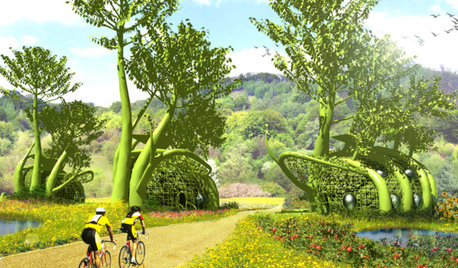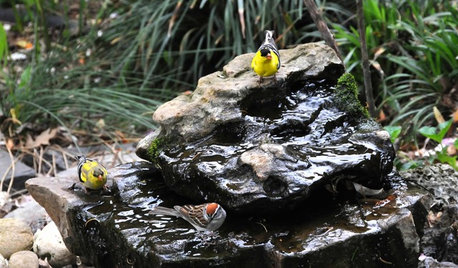Homemade potting soil / soil science questions
grrrnthumb
16 years ago
Related Stories

FARM YOUR YARDHow to Get Good Soil for Your Edible Garden
The nutrients in your soil feed the plants that feed you. Here are tips on getting it right — just in time for planting season
Full Story
GARDENING GUIDESHow to Pick a Mulch — and Why Your Soil Wants It
There's more to topdressing than shredded wood. Learn about mulch types, costs and design considerations here
Full Story
GARDENING GUIDESHow to Stop Worrying and Start Loving Clay Soil
Clay has many more benefits than you might imagine
Full Story
GARDENING GUIDES10 Solutions for Soggy Soil
If a too-wet garden is raining on your parade, try these water-loving plants and other ideas for handling all of that H2O
Full Story
EVENTSOn Show: Weird, Wondrous Science Meets Design
Houses grown, not built. Power-generating soil. And snail poop that ... well, see for yourself in our coverage of a new Rotterdam exhibit
Full Story
OUTDOOR PROJECTSBring In the Birds With a Homemade Bubble Rock
An avian expert from Southern Indiana shows how to make a burbling fountain that migrating birds will love
Full Story
DECORATING GUIDES16 Lounges Go Wild for Science at San Francisco's Exploratorium
See the imaginative designs concocted and let us know which style formula works best for you
Full Story
CONTAINER GARDENSContainer Garden Basics: How and When to Water Potted Plants
Confused about soil moisture, the best time to water and what watering device to use? This guide can help
Full Story
GARDENING GUIDESGet on a Composting Kick (Hello, Free Fertilizer!)
Quit shelling out for pricey substitutes that aren’t even as good. Here’s how to give your soil the best while lightening your trash load
Full Story
GARDENING GUIDESNew Ways to Think About All That Mulch in the Garden
Before you go making a mountain out of a mulch hill, learn the facts about what your plants and soil really want
Full StoryMore Discussions










gardengal48 (PNW Z8/9)
grrrnthumbOriginal Author
Related Professionals
Windham Landscape Architects & Landscape Designers · Havre de Grace Landscape Architects & Landscape Designers · Billerica Landscape Contractors · Americus Landscape Contractors · Cincinnati Landscape Contractors · Edwardsville Landscape Contractors · Golden Gate Landscape Contractors · Middletown Landscape Contractors · Middletown Landscape Contractors · Natick Landscape Contractors · Ridgewood Landscape Contractors · Lockport Fence Contractors · Tacoma Fence Contractors · Yorba Linda Fence Contractors · Foster City Fence Contractorsmdvaden_of_oregon
grrrnthumbOriginal Author
gardengal48 (PNW Z8/9)
grrrnthumbOriginal Author
mdvaden_of_oregon
grrrnthumbOriginal Author
gardengal48 (PNW Z8/9)
mdvaden_of_oregon
ian_wa
grrrnthumbOriginal Author
nwnatural
greenelephant
grrrnthumbOriginal Author
sissysimone
grrrnthumbOriginal Author
brucestay
morz8 - Washington Coast
morz8 - Washington Coast
grrrnthumbOriginal Author
greenman28 NorCal 7b/8a
grrrnthumbOriginal Author
Embothrium
greenman28 NorCal 7b/8a
Embothrium
grrrnthumbOriginal Author
greenman28 NorCal 7b/8a
grrrnthumbOriginal Author
Embothrium
greenman28 NorCal 7b/8a
gardengal48 (PNW Z8/9)
Embothrium
tapla (mid-Michigan, USDA z5b-6a)
Embothrium
tapla (mid-Michigan, USDA z5b-6a)
Embothrium
tapla (mid-Michigan, USDA z5b-6a)
grrrnthumbOriginal Author
grrrnthumbOriginal Author
greenman28 NorCal 7b/8a
Embothrium
tapla (mid-Michigan, USDA z5b-6a)
grrrnthumbOriginal Author
tapla (mid-Michigan, USDA z5b-6a)
grrrnthumbOriginal Author
tapla (mid-Michigan, USDA z5b-6a)
grrrnthumbOriginal Author
maltby
James Tyrer